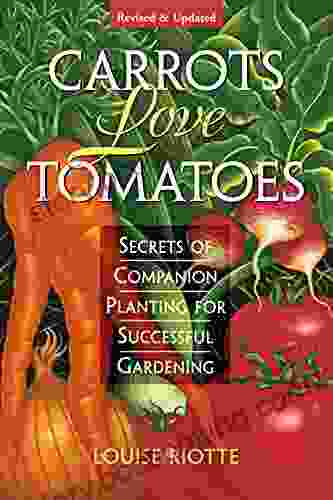Unlock the Secrets of Companion Planting for a Thriving Garden

Are you ready to transform your garden into a thriving oasis of abundance? Discover the ancient art of companion planting, a time-tested technique that has been passed down through generations of gardeners. With the wisdom of companion planting, you'll unleash the power of plant synergy, maximizing your garden's yield and overall health. Prepare to be amazed as we delve into the fascinating world of companion planting, where plants form mutually beneficial relationships, creating a vibrant and productive ecosystem in your backyard.
4.7 out of 5
| Language | : | English |
| File size | : | 5618 KB |
| Text-to-Speech | : | Enabled |
| Screen Reader | : | Supported |
| Enhanced typesetting | : | Enabled |
| X-Ray | : | Enabled |
| Print length | : | 302 pages |
| Lending | : | Enabled |
The Art of Companion Planting
What is Companion Planting?
Companion planting is the practice of strategically planting different species of plants close together to enhance their growth and productivity. It's like creating a harmonious community of plants, where each member contributes unique benefits to the ecosystem. By carefully matching compatible plants, you can improve soil fertility, deter pests and diseases, and boost overall yield.
Benefits of Companion Planting
- Increased Yield: Companion planting can significantly increase the yield of your garden by optimizing the use of space, nutrients, and sunlight.
- Improved Soil Health: Certain companion plants help improve soil fertility by fixing nitrogen, suppressing weeds, and attracting beneficial microorganisms.
- Pest and Disease Control: Companion planting can naturally deter pests and diseases by creating unfavorable conditions for them or by attracting beneficial insects that prey on pests.
- Enhanced Pollination: Some companion plants attract pollinators, increasing the number of insects available to pollinate your fruits and vegetables.
- Water Conservation: Companion planting helps conserve water by creating a living mulch that retains moisture in the soil.
Choosing Compatible Companion Plants
Factors to Consider
- Plant Needs: Consider the light, water, and nutrient requirements of the plants you want to companion plant to ensure they have compatible needs.
- Growth Habits: Pay attention to the size, shape, and growth rate of the plants. Avoid planting tall plants next to short ones or fast-growing plants next to slow-growing ones.
- Root Systems: Consider the depth and spread of the plants' root systems to avoid competition for water and nutrients.
- Allelopathy: Some plants release chemicals that can inhibit the growth of other plants. Research which plants have allelopathic properties and avoid planting them together.
- Beneficial Interactions: Look for plants that have mutually beneficial relationships, such as nitrogen-fixing plants or plants that attract pollinators.
Proven Companion Plant Combinations
| Plant A | Plant B | Benefits |
|---|---|---|
| Tomatoes | Basil | Basil repels tomato hornworms and improves tomato flavor. |
| Carrots | Onions | Onions deter carrot flies, while carrots loosen the soil for onions. |
| Beans | Corn | Beans fix nitrogen in the soil, benefiting corn. Corn provides support for beans to climb. |
| Marigolds | Vegetables | Marigolds repel nematodes and other soil-borne pests. |
| Lavender | Roses | Lavender attracts pollinators and repels aphids that damage roses. |
Practical Applications of Companion Planting
Designing Your Companion Planting Garden
- Plan your garden layout: Create a map of your garden, indicating where you want to plant each companion planting combination.
- Prepare your soil: Amend the soil with organic matter to improve its fertility and structure.
- Plant in succession: Plant different companion plants in succession to extend the harvest season and optimize space utilization.
- Mulch around plants: Spread a layer of mulch around your plants to retain moisture, suppress weeds, and attract beneficial organisms.
- Monitor and adjust: Observe your garden regularly and make adjustments as needed. Companion planting is not a static practice; it requires ongoing care and adaptation.
Unlock the Potential of Your Garden
Transform Your Garden with "Secrets of Companion Planting"
Are you ready to unlock the secrets of companion planting and transform your garden into a thriving oasis? Our comprehensive guide, "Secrets of Companion Planting," will empower you with the knowledge and techniques you need to maximize your garden's yield, improve its health, and enjoy the beauty of a harmonious ecosystem.
Free Download Your Copy Today!
Frequently Asked Questions
- Do all plants benefit from companion planting?
While most plants can benefit from companion planting, there are a few exceptions, such as plants that release allelopathic chemicals. It's important to research specific plant combinations before planting.
- How close should I plant companion plants?
The ideal spacing between companion plants depends on their size and growth habits. In general, taller plants should be planted further apart to avoid shading out smaller plants.
- Can I practice companion planting in containers?
Yes, companion planting can be successfully implemented in containers. Just be mindful of the size and root systems of the plants you choose.
Unlock the power of companion planting and watch your garden flourish! By embracing this ancient technique, you'll create a thriving ecosystem where plants support and enhance each other's growth and well-being. Whether you're a seasoned gardener or just starting out, the "Secrets of Companion Planting" guide will equip you with the knowledge and inspiration you need to transform your garden into a vibrant oasis of abundance. Free Download your copy today and start reaping the rewards of companion planting!
4.7 out of 5
| Language | : | English |
| File size | : | 5618 KB |
| Text-to-Speech | : | Enabled |
| Screen Reader | : | Supported |
| Enhanced typesetting | : | Enabled |
| X-Ray | : | Enabled |
| Print length | : | 302 pages |
| Lending | : | Enabled |
Do you want to contribute by writing guest posts on this blog?
Please contact us and send us a resume of previous articles that you have written.
 Book
Book Novel
Novel Page
Page Chapter
Chapter Text
Text Story
Story Genre
Genre Reader
Reader Library
Library Paperback
Paperback E-book
E-book Magazine
Magazine Newspaper
Newspaper Paragraph
Paragraph Sentence
Sentence Bookmark
Bookmark Shelf
Shelf Glossary
Glossary Bibliography
Bibliography Foreword
Foreword Preface
Preface Synopsis
Synopsis Annotation
Annotation Footnote
Footnote Manuscript
Manuscript Scroll
Scroll Codex
Codex Tome
Tome Bestseller
Bestseller Classics
Classics Library card
Library card Narrative
Narrative Biography
Biography Autobiography
Autobiography Memoir
Memoir Reference
Reference Encyclopedia
Encyclopedia Simon Doonan
Simon Doonan Lora Mcclain Muhammad
Lora Mcclain Muhammad Thomas Graham Morry
Thomas Graham Morry Wilma King
Wilma King Lolo Smith
Lolo Smith Mandi Welbaum
Mandi Welbaum Marc Vachon
Marc Vachon Margaret Heffernan
Margaret Heffernan Marcos C S Carreira
Marcos C S Carreira Stephen Wilbers
Stephen Wilbers Scott Patterson
Scott Patterson Paul Jenkins
Paul Jenkins Maia Szalavitz
Maia Szalavitz Marc Bubbs
Marc Bubbs Louis Martin
Louis Martin Toni Petniunas
Toni Petniunas Tom Reiss
Tom Reiss Tom Alesia
Tom Alesia M Kevin Davis
M Kevin Davis Lynda Madaras
Lynda Madaras
Light bulbAdvertise smarter! Our strategic ad space ensures maximum exposure. Reserve your spot today!

 Aldous HuxleyUnveil the Truth: Empower Yourself with "Abolitionist Tools for the New Jim...
Aldous HuxleyUnveil the Truth: Empower Yourself with "Abolitionist Tools for the New Jim... Melvin BlairFollow ·11.1k
Melvin BlairFollow ·11.1k Herbert CoxFollow ·5.6k
Herbert CoxFollow ·5.6k Kurt VonnegutFollow ·15.9k
Kurt VonnegutFollow ·15.9k Bryan GrayFollow ·16.3k
Bryan GrayFollow ·16.3k Jules VerneFollow ·4.8k
Jules VerneFollow ·4.8k Theo CoxFollow ·14.3k
Theo CoxFollow ·14.3k Percy Bysshe ShelleyFollow ·18.7k
Percy Bysshe ShelleyFollow ·18.7k Jerry HayesFollow ·17.5k
Jerry HayesFollow ·17.5k

 Truman Capote
Truman CapoteShort, Skinny Mark Tatulli: The Ultimate Guide to a...
Are you tired of being...

 Robert Heinlein
Robert HeinleinEmbark on an Unforgettable Cycling Adventure: The Classic...
Explore the Timeless...

 Bryce Foster
Bryce FosterMisty Twilight: Marguerite Henry's Enduring Masterpiece
A Literary Legacy that...

 Anton Chekhov
Anton ChekhovUnleash the Explosive Power of DC Comics Bombshells 2024...
Prepare yourself for an...

 Juan Butler
Juan ButlerUnleash the Thrill: Discover 'Know Your Rider' by...
Prepare yourself for an...
4.7 out of 5
| Language | : | English |
| File size | : | 5618 KB |
| Text-to-Speech | : | Enabled |
| Screen Reader | : | Supported |
| Enhanced typesetting | : | Enabled |
| X-Ray | : | Enabled |
| Print length | : | 302 pages |
| Lending | : | Enabled |












